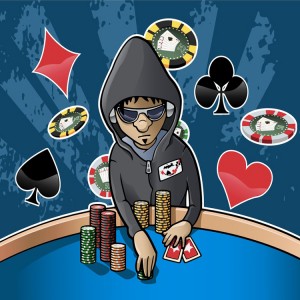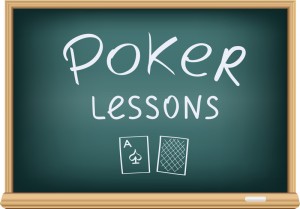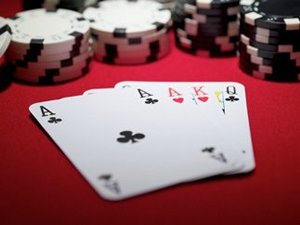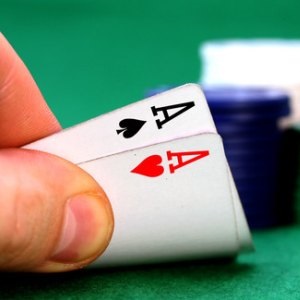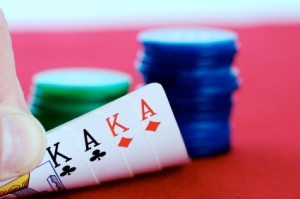Every player at some point has the experience of playing with a maniac. Nothing changes a poker game quite as much as a loose aggressive player sitting down and taking charge of the game. All of a sudden the game turns upside down, and you no longer feel in control. You are playing a game that is still poker, but nothing like the game you have been playing up until now.Amongst other things you might find:
– Far more pots are raised and re-raised pre-flop
– You are paying multiple bets on all streets with hands you rather wouldn’t
– You are winning big pots with the unlikeliest of hands
– You are losing big pots with mediocre holdings you would normally have folded long ago.
– You lose faith in your reads and instincts
– All your other opponents are suddenly behaving erratically and unpredictably.
At this point you must adapt or be trampled. This was originally a two-part article which we’ve now combined to be a complete guide to dealing with maniacs at the table. We’ll categorise different types of maniacs and will give some general advice for coping when they join your game. Then we will look in more detail at the changes you will need to make to adapt to the maniac. Hopefully next time you play you will be eagerly anticipating the maniac rather than dreading his arrival.
Different Types of Maniacs
‘Maniac’ is a slang description for a player who is both loose and aggressive. Normally it is used to describe a player who is extremely loose and extremely aggressive, but much of the advice in this article also applies to players who are just more loose and aggressive than most (or LAGs as they are often called). A maniac is usually the most visible player at the table, because they are involved in a lot of hands and are usually the aggressor. Most maniacs are long-term losers. In fact, no style of play has the potential to lose you more money more quickly than an extreme loose/aggressive style.
Not all maniacs are created equal. All they have in common is that they play aggressively and too loose. Their exact play-styles and indeed their motives differ greatly. In order to understand how to adapt to a particular maniac, you need to first identify what type of maniac they are. Don’t fall into the trap of stereotyping a player based on some observed loose-aggressive tendencies. The following are the seven most common types of maniacs you will encounter at the table:
True manic
The ‘true’ maniac will raise and re-raise repeatedly regardless of the strength of their hand. They probably play upwards of 70% of hands and are extremely aggressive on all streets. It is difficult to pinpoint any kind of motive for a true maniac, because their actions appear almost random. Most often they are just gamblers who want to get all their money in and then hope they win, with little regard for how strong their hand actually is. They are not really playing poker, but more playing a lottery.
Action junkie
An action junkie is a player who simply loves being involved in hands, betting and raising. They differ from the true maniac because they do actually try to play the game properly. Unfortunately they are just too hooked on the thrill of gambling to play disciplined poker. They enjoy being the centre of attention and live for the day when the stars align right and they post a big win.
Wild/drunk player
This type of player is trying to play good poker (or at least their own definition of it), but they simply overestimate how many hands they should be playing and how much they should be raising. This might be because they are naturally a wild player or because they are drunk and their judgement is impaired. Their play may be anything from slightly loose/aggressive to a full-blown maniac.
Steamer
A steamer is a player who is playing too loose and aggressive due to tilt. They will be playing too many hands and raising aggressively either to try and win some pots to get back money that they have lost, or because they are angry and simply expressing that anger by proverbially throwing chips around. Sometimes their anger is directed at one particular player, and you will find that their wild raises actually only occur when that particular player is in the pot.
Bulldozer
A bulldozer is not a maniac in the classic sense. They are certainly loose and aggressive and will generally keep betting until they meet resistance regardless of their holding. The difference between these and most other types of maniac is that if you push back enough, they will tend to back off or fold if their hand is weak. These can be difficult players to play against because they will not give too much action if they are weak, but if they have a good hand you will often end up paying them off. Your edge against these players is that you will have the best hand more often.
One-street maniac
Sometimes you will get a maniac who is only loose and aggressive on one particular street. Sometimes they always raise pre-flop but then try to play well post-flop. Some raise or re-raise the flop if they have hit any part of it but tighten up after that. Some always raise the river hoping for a free pot. These are generally players who have learned a trick or concept but have taken it too far.
Shark in disguise
It is rare (especially in limit hold’em), but sometimes you will meet a strong player who appears to be a maniac or at least loose aggressive. They will raise a broad spectrum of hands pre-flop and will put a lot of pressure on you after the flop. The difference is they will have a good sense of when they are beat and will be able to let go of their hand. You need to be wary of these players, even though they are probably playing sub-optimally.
Fundamental Adjustments
It is important to make the correct adjustments when playing with maniacs, and many of these adjustments occur within your own head. Some players are extremely bad at this, and hate it when a maniac sits down. Some will even leave the table because they are unable to cope with the fact that the game has changed. You don’t want to be one of these players. You want to be able to take full advantage of having a maniac at your table, and you can do this by:
1. Learning how to adapt your game to cope with a maniac. This will be covered next month in the second part of this article.
2. Have the correct attitude towards maniacs, and know and accept how they affect the game. This is discussed below.
Maniacs are your friend
Maniacs are nearly all long-term losers. Over the course of time they will lose a lot of chips to the other players at the table, including you if you play correctly. They should be welcomed to your table just the same as any other bad player would, because they represent a big jump in your expected win rate. Don’t listen to the other players who moan when a maniac is at the table. In fact, be happy that they seem unable to adapt and take advantage of it.
Be prepared for the swings
When a maniac is playing, the average pot size goes way up and you are often forced to commit a lot of chips with some marginal hands. Also there will be times where you have a legitimate hand and the maniac raises all the way only to back into an unlikely straight, flush or trips which you will pay off. The swings you experience when a maniac is at the table can be large, and this puts a lot of players off. When you play with a maniac, recognise that you will get burned some hands or maybe the session as a whole. It doesn’t matter if you beat this maniac in this particular session, providing you make the right decisions that will make you money in the long run.
Acknowledge that the game has changed
When a maniac sits down the game completely changes and you must acknowledge this. If you try to play your normal game you will struggle, or at least miss opportunities. The fact that you are a ‘better player’ will not beat the maniac on its own. It is adapting to the maniac and using his weaknesses against him that will win you the money.
Tackle the maniac on your own terms
Sometimes your ego gets in the way when you are playing poker. If a player is running over the table, you will try to ‘put him in his place’ by beating him at his own game, but this is rarely a good idea. A maniac’s strengths are that he is almost impossible to read and he will pick up a lot of pots where everyone misses. Don’t try to beat him by doing the same thing, because quite frankly he is probably better at it than you. Tackle a maniac through his weaknesses instead. Take him on when you have a strong hand, not a weak one. He wants to see weakness so show him weakness by folding to his raises, then strike when you have the goods. Make him play your game, rather than trying to play his. Let him have the respect and fear of the other players, while you quietly accumulate the cash.
Maniacs can be beaten, and can actually be beaten rather easily if you know how. Having the correct attitude towards them is the first step. Now that we’ve defined the different types of maniacs you might encounter and went through the basic mental adjustments you need to make when you have a maniac at your table, we’ll now look look more closely at the changes you will need to make to your game when up against a maniac. We will also discuss how your opponent’s play may have changed and how you should adapt to that.
Adjusting Your Play
A maniac sitting at the table is an excellent opportunity for you to make money, but you must make the correct adjustments. In fact, adjusting properly to a maniac is more important that for any other type of player you will encounter. If a tight player sits down, they won’t be playing many hands so you won’t tangle with them on many hands. If a loose passive player sits down then you can beat them by playing your usual game. Loose aggressive players are unique in that you must adapt your entire game to accommodate them.
Seating
If at all possible, try to get the seat to the immediate left of the maniac. There are three reasons for this:
1. You want to know what the maniac will do before you act. It is difficult to make decisions when there is a very good chance the pot is being raised behind you.
2. You have a better chance of being able to isolate the maniac (see ‘isolating’ below).
3. Your opponents will find it hard to isolate the maniac at your expense.
If you can’t get this seat for any reason, then sit as close to the maniac’s left as possible. The only exception to this rule is if the maniac is extremely predictable. For example, if you knew a player would raise 100% of the time then the best seat is to his right. You can then raise and let him isolate you. The difficulty in making decisions would be gone, because you know not to call any bet unless you are prepared to call at least one more. However, it is rare to meet a maniac this predictable so if in doubt, always sit to his left.
Loosening up
If you are in a pot with a maniac who is very loose, you will need to loosen up yourself somewhat, especially post flop. Otherwise every time you are heads up and neither of you have much of a hand he will take the pot, which over time adds up to a ton of value lost. The problem is that unlike a loose passive player, a LAG will make you pay to go to showdown, and it will be difficult to put him on a hand. It can be very annoying to repeatedly fold middle pair to a maniac’s raises and see him show down garbage, and then the one time you call him down he has top pair.
For this reason it is important to study the maniac carefully to see what his standards are. Even maniacs will tend to act differently with a good hand as opposed to a bad one even if it means, for example, he will put four bets in on the flop rather than three. If you have a solid hand, put him to the test early, with a re-raise on the flop. If he fights back too hard you can call down or fold, whereas if he backs off you can keep value betting until you meet resistance.
Be especially careful when there are other players in the hand. You may get into a raising war with the maniac with a solid hand, only to find that a third player who has been happily calling along has you beat. Later in this article we will be discussing further how to adapt to your other opponents when you have a maniac at the table.
Isolating
Wherever possible you want to be heads up against the maniac. When you are heads up, not only do you have the best hand more often than not, but also control the number of bets that go in to a large extent. This makes such situations very profitable in the long run. If other players come along for the ride, you are far less likely to have the best hand, especially if they have not loosened up their starting hand requirements to the extent that you have.
Isolating means raising not strictly for value, but in the hope of getting heads up against a weak player. In the case of a maniac it normally means sitting to their left and re-raising them, leaving all the other players facing three bets. Hopefully the outcome will be that you end up heads-up against the maniac with position.
Naturally you shouldn’t isolate the maniac every time he raises. The idea is to get in a heads up situation with a better hand. If you get too carried away with isolating the maniac, you will find yourself raising with substandard hands and turning into a maniac yourself. Not only is this something your other opponents can exploit, but it also reduces or eliminates the main advantage you had over the maniac in the first place, which was your better average hand quality.
Value betting/raising
One of the most difficult things you have to do against a maniac is determine correctly when you should be value betting and raising. For most players, their first instinct is to play too cautiously as they are reluctant to lose too many big bets with a beatable hand. Instead they will settle for just calling the maniac down with moderate holdings rather than put in the value bets and raises that the situation demands. It does not seem natural to raise the turn with just top pair after your opponent has capped the flop, but against an opponent who will cap the flop with any pair or any draw, this is the correct thing to do. The river has its own particular problems, because you no longer have the incentive of ‘protecting your hand’. If you have two pair and the three-flush hits on the river, it is normally right to raise a maniac, despite every instinct screaming that it is wrong. You won’t be ahead every time, but you will win enough to turn a profit on the bet in the long run.
On the other hand, you must be careful not to go too far the other way. Just because a player is raising and re-raising with garbage, doesn’t mean he always has garbage. A good player will get dealt aces once every 221 hands, a maniac just as often. You shouldn’t keep raising all the way to the river when the balance of probability dictates that the maniac has probably made a hand that beats you by now. This is especially true when you had a good starting hand such as AK, which you may have become attached to.
Your best tool in knowing when to value bet is to study the maniac carefully. As discussed last month, not all maniacs are the same. Some have more standards than others, some are more aggressive on certain streets, some are capable of folding a hand etc. For example, against some maniacs, a raise on the turn means they have at least second pair. Against others it simply means they still have two cards and some chips. However that doesn’t necessarily mean that either player doesn’t have top set. Study the maniac carefully on every hand and slowly build up a picture of their game. Once you have a better idea of his standards, your decisions become far easier.
Deception
Generally speaking, it is not a good idea to bluff or slow-play a maniac. There is no point in misrepresenting your hand to a player who isn’t even thinking about what you might have. Bluffing and semi-bluffing are pointless because they will probably call or raise you even with a weak hand. Slowplaying is a bad idea because they will probably pay you off anyway and then some. Simply calling a flop bet with a monster may cost you three extra small bets that the maniac would have been happy to pay.
However, that is not to say you should never use deception against a maniac. Certain types of maniac do pay attention to your betting and respond to it. For example you sometimes meet players who try to run over the table but back off if they meet too much resistance (profiled as ‘the bulldozer in last month’s article). It may be optimal to slowplay these players in certain situations, or even attempt a bluff if the situation is right. Remember though that against these players, slowplaying runs the same risks that it does against any other player:
1. You may get outdrawn
2. Your opponent may have a good hand too and be willing to pay you off anyway.
When in doubt it is best just to bet your hand.
Your Other Opponents
When playing with a maniac, it is easy to focus all your attention on him, while forgetting about your other opponents. This is a big mistake because it is pointless to play the maniac perfectly only to lose all of your money to the other players. Generally speaking, the maniac will not be in every hand (although some come close) and so in these other hands, you will need to make the correct decisions exactly as you would at any other time.
Additionally you won’t always be able to get heads-up with the maniac. Sometimes another opponent will wake up with a good hand, while other times they will just come along for the ride, wanting a piece of the action the maniac is dishing out. Either way you will end up in a multi-way pot, which can be a difficult situation. You will have to work out where you stand in relation to both the maniac and to the other players in the hand. Here it definitely helps if you are to the left of the maniac as you can raise to try and knock the other player out. However, if it appears the other player has a hand and you don’t, it may be time to bail because the last thing you want to do is get in the middle of a raising war with a mediocre hand.
One thing it is very important to do is observe how your opponents are reacting to the maniac. Some will fail to react at all, and try to get by playing their regular game. Some will make some or all of the necessary adjustments to compensate for the maniac as described in this article. Some will react to the maniac but in a bad way, their game deteriorating. Every opponent will react differently and it is often difficult to keep track. A player who you know as tight and conservative may suddenly become loose and aggressive when the maniac is in the hand. An aggressive player might suddenly become passive, a semi-loose player may tighten up. In fact, you may have to forget everything you have learned about your opponents in the past and start again.
Taking this to the next level, you must also look at how your opponents perceive you. Your attempts to isolate the maniac may lead your opponents to think that you are a wild aggressive player yourself and they may act accordingly. Alternatively they may ignore you completely, because their attention is focussed on the maniac. I remember one hand where I played a 3-way pot against an extreme maniac and another player. I flopped quads and every street was capped without me having to raise once. The other player seemed to forget I was in the hand, and just carried on raising with his top pair.
Conclusion
A maniac sitting down upsets the whole dynamic of the table. The first player to figure it out will be the one who stands to profit the most. It can be a great opportunity, representing a big jump in expectation for you, but to take advantage you will need to make the right adjustments. Make sure you are prepared so that the next time it happens, it will be you raking in the money, while your other opponents sit there grumbling, wondering what happened.
Submit your review | |

